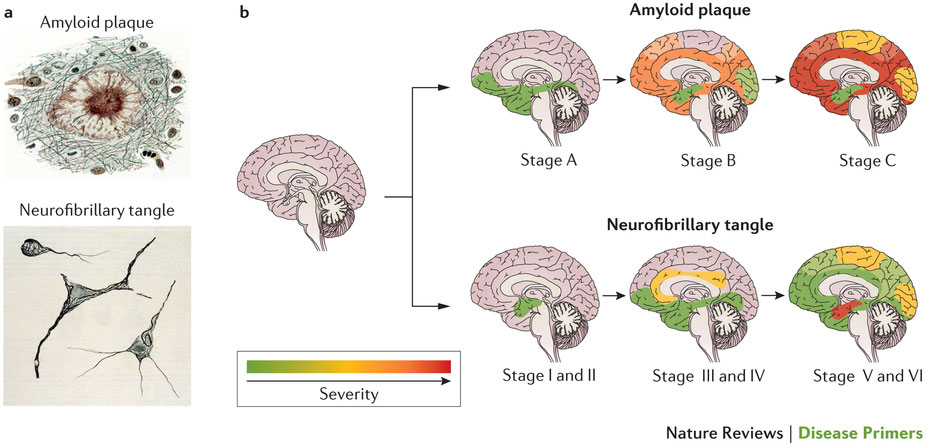Review Abstract
アルツハイマー病
Alzheimer's disease
2015年10月15日 Nature Reviews Disease Primers Article number: 15056 (2015) doi: 10.1038/nrdp.2015.56

アルツハイマー病は、無症状期と前駆症状期が長期に及ぶ(20年)慢性疾患で、平均的な臨床期間は8~10年といわれている。65歳以上の一般集団におけるこの疾患の有病率は10~30%で発症率は1~3%と推定されている。ほとんどのアルツハイマー病患者(95%以上)は散発型で、高齢(80~90歳)での発症を特徴とする。これは、脳の間質からアミロイドβ(Aβ)ペプチドを除去できなかった結果と考えられている。この散発性疾患には非常に多くの遺伝的リスク因子が同定されている。一方で、Aβのプロセッシングに影響し、より若年期(平均年齢45歳程度)に発症する遺伝子変異を先天的に有している患者も少数見られる(1%未満)。現在、脳脊椎液のバイオマーカーとPETを使用して、無症状期と前駆症状期でもAβ蓄積の検出が可能となっている。承認薬の中にはアルツハイマー病の症状を改善させるものもいくつかあるが、この疾患の発症機構を修飾できる介入は今のところ存在しない。現在の管理方法は、患者を取り巻く社会的ネットワークによる支援と脳血管疾患などの合併疾患の治療に絞られている。
PrimeView
アルツハイマー病は、神経細胞におけるアミロイドβの細胞外蓄積および微小管タンパク質タウの凝集が関連する神経変性疾患である。このPrimeViewでは、Colin Mastersらが執筆したPrimerの重要な点について要約する。
本Primerの図解サマリー
Alzheimer's disease is a chronic illness with long preclinical and prodromal phases (20 years) and an average clinical duration of 8–10 years. The disease has an estimated prevalence of 10–30% in the population >65 years of age with an incidence of 1–3%. Most patients with Alzheimer's disease (>95%) have the sporadic form, which is characterized by a late onset (80–90 years of age), and is the consequence of the failure to clear the amyloid-β (Aβ) peptide from the interstices of the brain. A large number of genetic risk factors for sporadic disease have been identified. A small proportion of patients (<1%) have inherited mutations in genes that affect processing of Aβ and develop the disease at a much younger age (mean age of ∼45 years). Detection of the accumulation of Aβ is now possible in preclinical and prodromal phases using cerebrospinal fluid biomarkers and PET. Several approved drugs ameliorate some of the symptoms of Alzheimer's disease, but no current interventions can modify the underlying disease mechanisms. Management is focused on the support of the social networks surrounding the patient and the treatment of any co-morbid illnesses, such as cerebrovascular disease.

